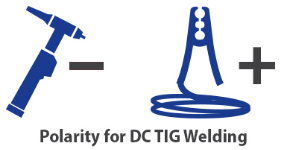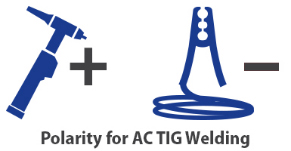The acronym TIG stands for Tungsten I nert G as . Tungsten refers to the type of conductor (tungsten electrode) used to transfer the welding current to the work and create the arc. Inert gas refers to the fact that the process relies on an inert gas (such as argon) to protect the weld and prevent oxidation of the weld.
TIG is also known as gas tungsten arc welding (GTAW).
Simply put, TIG welding is probably most similar to oxy-fuel welding. However, instead of a flame, it uses an arc to melt the workpiece and filler metal, rather than a preheated flame, and it uses an inert gas to prevent weld oxidation. As with oxy-flame welding, the filler metal is manually fed into the weld as needed. Since the current is not conducted through the filler metal to the workpiece (as in MIG and MMA welding), the arc is more controllable.
Very low amperage can be achieved, making the process ideal for welding thin materials. In addition, due to the independence of the arc and filler metal application, TIG welding is very controllable, resulting in very high quality welds and excellent appearance. Unlike MIG and MMA welding, TIG welding does not produce spatter, so cleanup is minimal.
TIG is often used for welding where appearance is important (e.g. handrails) or where weld quality is critical (e.g. pressure vessels or pipes).
While TIG welding is very controllable, it can also be slower and more tedious than MIG or rod/MMA welding, and it usually does not work well on dirty or rusty materials, which means that additional weld preparation is sometimes required.
"DC" (direct current) TIG welders can be used to weld a variety of "ferrous" metals, including mild and stainless steels, as well as copper and chromium-molybdenum alloys. (but not aluminum).
Many, but not all, inverter rod/MMA welders have DC TIG capability.
An important feature for effective TIG welding is elevated arc ignition.
To weld aluminum, you need a machine with "AC" (alternating current) capability.
These machines typically have both AC and DC capability in one machine ("AC/DC") - which allows them to weld most metals, including: aluminum, steel, stainless steel, copper, chromium-molybdenum, and more.
Typical AC/DC machines that are dedicated TIG welders (sometimes with stick/MMA capability as an add-on).
Most common TIG welding applications require pure argon (100% Ar). Some critical applications may require specialty gases.
Polarity refers to the direction of current flow during welding.
All DC TIG welding (steel, stainless steel, etc.) is done on a DC polarity where the TIG torch is connected to the negative (-) terminal and the ground is connected to the positive (+) terminal.

For AC TIG welding (aluminum), the polarity is usually* reversed from DC: the TIG torch is connected to the positive (+) terminal and the ground is connected to the negative (-) terminal.

*Note: Although "Torch Positive" is the most common polarity for AC/DC TIG welding, some AC/DC TIG machines may require "Torch Negative". Please consult your machine's instruction manual or contact the manufacturer.

The most common types of tungsten electrodes are as follows.
Tungsten for DC TIG welding of steel, stainless steel, chromium-molybdenum, copper.
Thorium (red tip)
Lanthanum 1.5% (gold tip)
Tungsten for AC welding of aluminum.
Zirconized (white tip)
Tungsten "all-metal" for AC or DC welding.
Rare earth (purple tip)
Lanthanide 2% (blue tip)
Ceriated (gray tip)
Rare earth tungsten is proven to perform well in AC and DC applications.
Previous: High Power Fiber Laser Cutting Machine
Copyright:@2020-2021
Comments Please sign in or sign up to post.
0
0 of 500 characters used